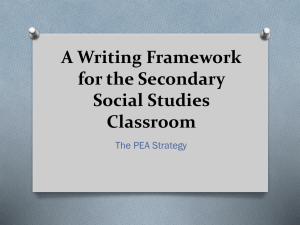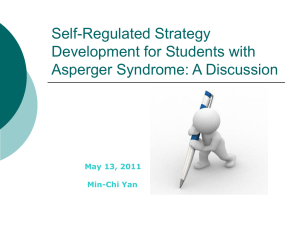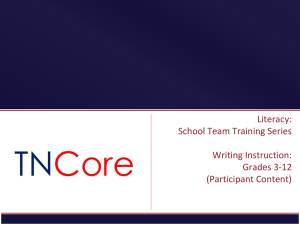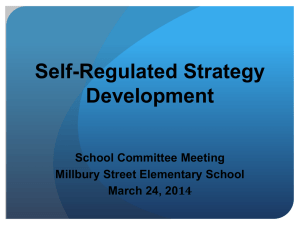Final Paper - Gmu - George Mason University
advertisement
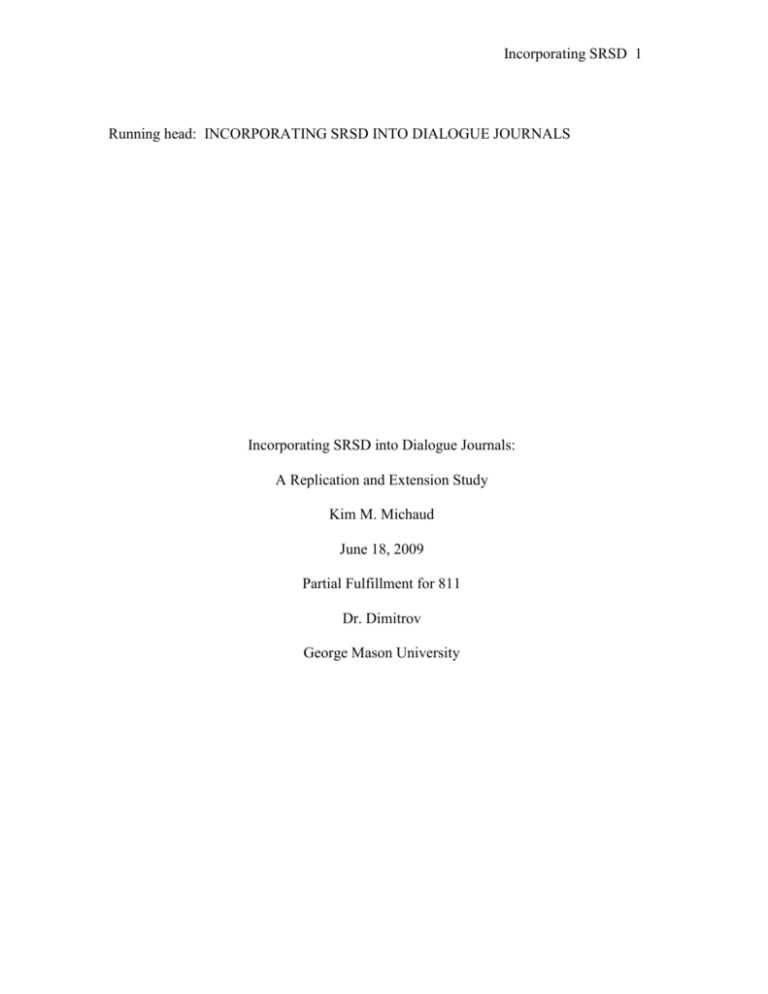
Incorporating SRSD 1 Running head: INCORPORATING SRSD INTO DIALOGUE JOURNALS Incorporating SRSD into Dialogue Journals: A Replication and Extension Study Kim M. Michaud June 18, 2009 Partial Fulfillment for 811 Dr. Dimitrov George Mason University Incorporating SRSD 2 Abstract This group design study compared the effects of three writing instruction strategies on 834 sixth grade students diagnosed with emotional and behavioral disturbances. Students were randomly selected from a list of students who met the criteria, and then randomly assigned to one of three instructional strategy groups. The three instructional strategies to be compared were: (a) dialogue journaling, (b) SRSD, and (c) a combination method that embeds the SRSD writing instruction into a modified dialogue journal intervention. ANOVAs were conducted comparing all dependent variables within and between groups using the Statistical Package for Social Sciences (SPSS) Version 17.0. A chi-square test was conducted comparing student attitudes towards the particular writing strategy they utilized. Results indicate that there are statistically significant findings in favor of both dialogue journaling and SRSD strategies which produced gains in written expression proficiency and its sub components of quality and quantity. Incorporating SRSD 3 Incorporating SRSD into Dialogue Journals: A Replication and Extension Study Regan, Mastropieri and Scruggs undertook their 2005 study based upon the research based evidence that students who struggle with emotional and behavioral disturbances typically have academic deficits, as well. They referred to Dunlap and Childs (1996), Anderson, Kutash, and Duchnowski (2001) and Cullinan and Sabornie (2004) who indicated that this population of students struggled both socially and academically. Indeed, according to Regan, Mastropieri and Scruggs, both Anderson, Kutash, and Duchnowski, and Cullinan and Sabornie revealed that these type of students, “typically function at least a year or more below grade level in most academic areas, have lower graduation rates, and are less likely to attend postsecondary school”(Regan, Mastropieri, & Scruggs, p. 33). Furthermore, their research indicated only a limited amount of research has been conducted on academic interventions for this population, and out of those studies only one concentrated on an area other than reading or math (Regan, Mastropieri, & Scruggs). Written expression is not only an important academic area, but also the research that Regan, Mastropieri and Scruggs referenced indicated that students with emotional and behavioral disturbances (EBD) had particular deficits expressing themselves in writing. For this reason, Regan, Mastropieri, and Scruggs chose to use a practice that could provide an opportunity for both social development and academic learning: dialogue journaling. “This practice provides opportunities for self-expression and problem-solving with an adult” (Regan, 2003; Young & Crow, 1992). This study used a multiple-baseline design to investigate the effects of dialogue journaling on on-task behavior, writing Incorporating SRSD 4 fluency and writing quality, for five sixth grade students with identified EBD. The results of this study indicated that though all participants increased their attention to task, and four out of five increased the number of words written, four out of five participants only slightly increased the quality of their writing. The authors surmised that the short length of the intervention combined with the lack of writing mechanics instruction could have resulted in the limited increase in writing quality for four of the five participants. Moreover, the fifth participant, identified has having autism, had a particular deficit with conservational ability, and therefore had great difficulty transferring oral language into text. Delano (2007) conducted a multiple-baseline design study to evaluate the effects of the evidenced based practice of Self-Regulated Strategy Development (SRSD) writing instruction (Graham, Harris, MacArthur, & Schwartz, 1991) on a 12 yr. old student with Asperger Syndrome. Though this study had only one participant, its positive results, combined with its intervention’s interactive type structure, could either provide a promising modification to Regan, Mastropieri, & Scruggs’ dialogue journal intervention, or perhaps could be equally, if not more effective by itself. It would be worthwhile to compare and contrast the effects of both methods on this population alongside a method which combines the two. The purpose of this study, therefore will be to compare and contrast the effects of three methods for students with EBD: (a) dialogue journaling, (b) SRSD, and (c) a method that embeds the SRSD writing instruction as described by Delano (2007) into a modified dialogue journal intervention as described by Regan, Mastropieri, & Scruggs (2005). Specifically this study will address the following research questions: Incorporating SRSD 5 1) Are there differences between the effects of these different instructional strategies on the dependent variables of writing quality as measured by a standardized writing measurement as both pre and post tests? 2) Are there differences between the effects of these different instructional strategies on the dependent variables of writing quality, and writing quantity as measured by researcher designed instruments and observations? 3) Do writing quantity and writing quality predict scores on a standardized writing assessment test? 4) Are there differences in attitudes of students about the effectiveness of the particular writing strategy that was used in their class to teach writing as measured by a questionnaire at the end of the treatment period? Method Participants Students. 835 students who met the inclusion criterion were randomly selected from six-grade classrooms of either self-contained schools for students diagnosed with emotional and behavior disturbances, or self-contained classrooms located in a large state of the eastern United States. These students were then randomly assigned to one of three groups for writing instruction. The students were between the ages of 11 and 12. They had behavioral goals included on their individualized educational plans (IEPs), and some had secondary disability characteristics, as well. The participants had to be able to independently compose at least three legible sentences, and to read on at least the secondgrade level, as assessed by the Informal Reading Inventory (IRI). Particular ethnic, gender, SES, and specific disability characteristics have been collected and separately reported. Incorporating SRSD 6 Staff. Staff included 20 special education teachers who hold advanced degrees in special education, and have experience teaching students with behavior challenges. In addition, there were 20 additional personnel who were either general education teachers or paraprofessional assistants. Particular ethnic, gender, education, and experience characteristics were collected and separately reported. Data Measurement, Collection and Analysis To answer the first research question, “are there any differences between the effects of these different instructional strategies on the dependent variables of writing quality as measured by a standardized writing measurement as both pre and post tests?” a norm referenced writing assessment test, the Mather-Woodcock Group Writing Test, was administered at the beginning and at the end of the study for all three groups. This test uses a T- scale (𝜇 = 50, 𝜎 = 10). A Gain score was calculated by subtracting all pretests from post tests from all three groups. An ANOVA was run using SPSS 17 to test if there were differences of Gain scores between groups, with the dependent variable being the Gain scores and the independent variables being the strategy groups (1= dialogue strategy, 2 = SRSD strategy, 3 = combination strategy). To answer the second research question, “Are there differences between the effects of these different instructional strategies on the dependent variables of writing quality, and writing quantity as measured by researcher designed instruments and observations?” data was collected as through the use of a variety of instruments. Quantitative measures listed below are to be defined according to Graham and Harris’ procedure as cited in Delano, 2007. These were assessed and recorded on a daily basis, and bi-weekly the scores were statistically evaluated across students and variables for each group. Incorporating SRSD 7 Total words written. The number of words that represent a spoken word, regardless of spelling will be counted. This was determined by computer after the student entries were typed into a computer. Action words. The number of different words that tell what people, things or animals do will be counted. This was measured independently by the two trained staff members. If 100% agreement was not reached, the average of the sum of their scores was submitted. Describing words. The number of different words that tell about the size, shape, color, number, feeling, etc. was counted. This was measured independently by two trained staff members. If 100% agreement was not reached, the average of the sum of their scores was submitted. Revisions. The number of changes made to the text that alter its meaning, such as adding more information was counted. This was measured independently by the two trained staff members. If 100% agreement was not reached, the average of the sum of their scores was submitted. Quality. The writings were assessed for overall quality based on organization, word choice, focus, and elaboration. This assessment was made by two scorers who independently read each sample and assigned a score from 1 to 7 points. The higher numbers indicated higher quality, and the scores were averaged to result in a single score. Quality, revision, describing word, and action word score results were collapsed into the dependent variable score “quality”, while total words written scores were described as the dependent variable “quantity.” The quality and quantity scores were transformed into T-scale so that they could be on the same scale as the pre and posttest Incorporating SRSD 8 scores utilizing the Mather-Woodcock Group Writing Test. Two separate ANOVAs were run using SPSS 17 with the dependent variables being quantity scores (Y2), and quality scores (Y3) and the independent variables being the strategy groups (1= dialogue strategy, 2 = SRSD strategy, 3 = combination strategy). To answer the third question, “Do writing quantity and writing quality predict scores on a standardized writing assessment test?” data scores on quantity, quality and the norm referenced posttest were used. These had been collected, transformed, and collapsed as described above. A multiple linear regression test was used using SPSS 17, with the dependent variable being the post test scores (Y4) and the predictor variable being quantity scores (Y2) and quality scores (Y3). To answer the fourth question, “Are there differences in attitudes of students about the effectiveness of the particular writing strategy that was used in their class to teach writing?” data was collected on a questionnaire after the strategy treatment was completed. The responses that were recorded were either positive (felt this new method helped me learn to write better) or negative (felt this new method did not help me learn to write better). A chi-square test was run using SPSS 17 in order to evaluate whether there was an association between positive or negative attitudes about the three particular writing strategies. The variables that were compared were the strategy groups (1= dialogue strategy, 2 = SRSD strategy, 3 = combination strategy) and the attitude responses (1 = negative, 2 = positive). RESULTS The results from the Omnibus F-test show that there are statistically significant Gain scores among the different writing strategy groups, F(2,832) = 53.95, p < .001. The Incorporating SRSD 9 descriptive statistics are shown in Table 1. Further, the Tukey Post Hoc test shows that there are statistical significance between Gain scores of all three groups, p < .001. The dialogue group outperformed both the SRSD and the combination groups, and the SRSD group outperformed the combination group. Specifically, the 95 % confidence interval shows that (a) the Gains scores of the students in the dialogue group were at least 2.5 but not more than 7 points higher than the SRSD group, (b) the Gains scores of the dialogue group were at least 8.6 but not more than 13.6 points higher than the combination group, and (c) the Gains scores of the SRSD group were at least 3.9 but not more than 8.7 higher than the combination group. The results for the omnibus F-test shows that there is a statistical significance in written quantity between the different writing strategy groups, F(2, 832) = 7.68, p < .001. The descriptive statistics are shown in Table 2. Further, the Tukey Post Hoc test shows that there is no statistical significant difference between the SRSD strategy group quantity scores and the quantity scores of the combination group. There is a statistical difference, however, between the quantity scores of the dialogue group and the SRSD group (p = .039), and between the dialogue group and the combination group (p < .001). Specifically, the 95% confidence interval shows that (a) the dialogue group scored higher on written quantity by at least 1.3 but not more than 5.5 points than the combination group, and (b) the dialogue group scored higher on written quantity by at least .08 but not more than 3.82 points than the SRSD group. The results from the omnibus F-test show that there are statistically significant differences in quality scores among the different strategy groups, F(2, 832) = 140.97, p < .001. The descriptive statistics are shown on Table 3. Furthermore, the Tukey Post Incorporating SRSD 10 Hoc test shows that though there is no statistical significant difference between the quality score of the dialogue group and the combination group, the SRSD group scores statistically significantly more than both the dialogue group (p < .001) and the combination group (p< .001). Specifically, the 95% confidence interval for the difference shows that (a) the SRSD group quality scores are higher than the dialogue group by at least 9 but no more than 12.7 point, and (b) the SRSD group quality scores are higher than the combination group by at least 10.35 but not more than 14.29 points. The results from the omnibus F-test shows that the prediction of written expression proficiency from written quality and written quantity scores are statistically significant, F(2, 832) = 57.843, p < .001. Further R2 = .122 shows that 12.2% of the variance of written expression proficiency is explained by the variances in written quality and written quantity. Also the regression coefficients for both predictors are statistically significant (p < .001 for written quantity, and p < .001 for written quality). This means that each predictor has a unique contribution to the prediction of written expression proficiency. Moreover, the part correlation between post test and quantity (rquantity = .187), thus (.187)2 = .035, which indicates that 3.5% of the variance in the post test score is uniquely contributed by variance in quantity score. The part correlation between post test and quality (rquality = .259), thus (.259)2 = .067, which indicates that 6.7% f the variance in the post test score is uniquely contributed by variance in the quality score Finally, the regression equation is: 𝑤𝑟𝑖𝑡𝑡𝑒𝑛̂ 𝑒𝑥𝑝𝑟𝑒𝑠𝑠𝑖𝑜𝑛 = .21 (𝑞𝑢𝑎𝑛𝑡𝑖𝑡𝑦) + .25 (𝑞𝑢𝑎𝑙𝑖𝑡𝑦) + 29.311 The results of the Pearson chi-square test shows that there is no statistically significant association between students’ attitudes (either positive or negative) towards the particular Incorporating SRSD 11 writing strategy that was employed to help them improve their written expression proficiency, though each group felt more positively than negatively about the strategy that was employed. Descriptive statistics are shown on Table 4. Discussion The results seemed to indicate that there might be some covariance factors that have not been identified during initial statistical analysis. As indicated by their Gain scores, dialogue groups increased their written expression proficiency over and above both SRSD and combination groups, and SRSD groups outperformed the combination groups. This, perhaps, is to be expected, since the embedded combination might not be able to be efficiently implemented. What is perplexing, however, is that though the dialogue groups produced statistically significant higher scores in quantity, quantity scores contributed only 3.5% of the variance in the post test scores, as opposed to quality’s contribution of 6.7%. There must be some other factor that has not been identified which is also contributing to the variance. In light of the fact that the overall student did response did not indicate a statistically significant preference, and that both dialogue and SRSD strategies produced statistically significant positive gain scores, it would appear that a choice of either method could produce satisfactory results for this population. The limitations of this particular study was that it did not investigate which method was most conducive from the educators’ perspective, and what other factors could be contributing to gains in written expression proficiency. Further study with less participants could perhaps uncover those variables. Incorporating SRSD 12 References Anderson, J.A., Kulash, K., & Duchnowski, A.J.(2001). A comparison of the academic progress of students with EBD and students with LD. Journal of Emotional and Behavioral Disorders, 9, 106-115.** Cullinan, D., Sabornie, E.J. (2004). Characteristics of emotional disturbance in middle and high school students. Journal of Emotional and Behavioral Disorders, 12, 157-167. ** Delano, M.E. (2007). Use of strategy instruction to improve the story writing skills of a student with Asperger Sydrome. Focus on Autism and Other Developmental Disabilities, 22(4), 252-258. Dunlap, G., & Childs, K.E., (1996). Intervention research in emotional and behavioral disorders: An analysis of studies from 1980 to 1993. Behavioral Disorders, 14, 157-165.** Graham, S., Harris, K.R., MacArthur, C., & Schwartz, S. (1991). Writing and writing instruction for students with learning disabilities: Review of a research program. Learning Disability Quarterly, 14, 89-114.* Regan, K. (2003). Using dialogue journals in the classroom: Forming relationships with the students with emotional disturbance. Teaching Exceptional Children, 36, 36-41.** Regan, K.S., Mastropieri, M.A., & Scruggs, T.E. (2005). Promoting expressive writing among students with emotional and behavior disturbance via dialogue journals. Behavioral Disorders, 31(1), 33-50. Incorporating SRSD 13 Young, T.A., & Crow, M.L. (1992). Using dialogue journals to help students deal with their problems. Clearing House, 65, 307-310.** * cited in Delano (2007). ** cited in Regan, Mastropieri, & Scruggs (2005). Incorporating SRSD 14 Table 1 Means and Standard Deviations for Three Writing Strategy Groups on Gain Scores Strategy N M SD Dialogue 272 7.97 12.27 SRSD 337 3.20 10.81 Combination 226 -3.08 12.70 Table 2 Means and Standard Deviations for Three Writing Strategy Groups on Quantity Scores Strategy N M SD dialogue 272 51.33 10.26 SRSD 337 49.39 9.63 combination 226 47.93 9.38 Table 3 Means and Standard Deviations for Three Writing Strategy Groups on Quality Scores Strategy N M SD dialogue 272 48.91 9.54 SRSD 337 59.75 9.46 combination 226 47.43 10.47 Incorporating SRSD 15 Table 4 Strategy*Attitude Crosstabulation Student Responses dialogue SRSD combination Total Total Yes No 88 184 -.6 .4 130 207 1.3 -.9 70 156 -.9 .7 288 547 272 337 226 835 Incorporating SRSD 16 APPENDIX Output results from ANOVA for Question # 1 Descriptive Statistics Dependent Variable:GAIN treatment Mean Std. Deviation N dialogue 7.9733 12.26598 272 SRSD 3.2036 10.81491 337 -3.0783 12.69673 226 3.0570 12.55360 835 combination Total Tests of Between-Subjects Effects Dependent Variable:GAIN Type III Sum of Source Squares df Mean Square F Sig. 15088.367a 2 7544.184 53.950 .000 Intercept 5925.423 1 5925.423 42.374 .000 treatment 15088.367 2 7544.184 53.950 .000 Error 116343.997 832 139.837 Total 139235.873 835 Corrected Total 131432.364 834 Corrected Model a. R Squared = .115 (Adjusted R Squared = .113) Incorporating SRSD 17 GAIN Tukey HSD 95% Confidence Interval Mean Difference (I) treatment (J) treatment dialogue SRSD SRSD (I-J) Lower Bound Upper Bound .96387 .000 2.5066 7.0328 combination 11.0515* 1.06435 .000 8.5525 13.5505 dialogue -4.7697* .96387 .000 -7.0328 -2.5066 6.2818* 1.01671 .000 3.8947 8.6690 -11.0515* 1.06435 .000 -13.5505 -8.5525 -6.2818* 1.01671 .000 -8.6690 -3.8947 dialogue SRSD Based on observed means. The error term is Mean Square(Error) = 139.837. Output for Question 2 (2 separate ANOVAs run Descriptive Statistics Dependent Variable:quantity treatment Sig. 4.7697* combination combination Std. Error Mean Std. Deviation N dialogue 51.3347 10.25621 272 SRSD 49.3858 9.62793 337 combination 47.9258 9.37820 226 Total 49.6255 9.84950 835 Incorporating SRSD 18 Tests of Between-Subjects Effects Dependent Variable:quantity Type III Sum of Source Squares df Mean Square F Sig. 1466.961a 2 733.480 7.682 .000 1996251.832 1 1996251.832 20906.965 .000 1466.961 2 733.480 7.682 .000 Error 79441.543 832 95.483 Total 2137255.045 835 80908.504 834 Corrected Model Intercept treatment Corrected Total a. R Squared = .018 (Adjusted R Squared = .016) Multiple Comparisons quantity Tukey HSD 95% Confidence Interval Mean Difference (I) treatment (J) treatment dialogue SRSD 1.9489* .79647 .039 .0789 3.8190 combination 3.4090* .87950 .000 1.3440 5.4740 -1.9489* .79647 .039 -3.8190 -.0789 1.4601 .84013 .192 -.5125 3.4326 dialogue -3.4090* .87950 .000 -5.4740 -1.3440 SRSD -1.4601 .84013 .192 -3.4326 .5125 SRSD dialogue combination combination (I-J) Based on observed means. The error term is Mean Square(Error) = 95.483. *. The mean difference is significant at the .05 level. Std. Error Sig. Lower Bound Upper Bound Incorporating SRSD 19 Descriptive Statistics Dependent Variable:quality treatment Mean Std. Deviation N dialogue 48.9104 9.54180 272 SRSD 59.7532 9.46129 337 combination 47.4321 10.47107 226 Total 52.8863 11.29154 835 Tests of Between-Subjects Effects Dependent Variable:quality Type III Sum of Source Squares df Mean Square F Sig. 26913.621a 2 13456.810 140.972 .000 2201347.755 1 2201347.755 23061.059 .000 treatment 26913.621 2 13456.810 140.972 .000 Error 79420.521 832 95.457 Total 2441800.444 835 106334.142 834 Corrected Model Intercept Corrected Total a. R Squared = .253 (Adjusted R Squared = .251) Incorporating SRSD 20 Multiple Comparisons quality Tukey HSD 95% Confidence Interval Mean Difference (I) treatment (J) treatment dialogue SRSD (I-J) combination Sig. Lower Bound Upper Bound -10.8427* .79637 .000 -12.7125 -8.9729 1.4783 .87939 .213 -.5864 3.5430 dialogue 10.8427* .79637 .000 8.9729 12.7125 combination 12.3211* .84002 .000 10.3488 14.2934 -1.4783 .87939 .213 -3.5430 .5864 -12.3211* .84002 .000 -14.2934 -10.3488 combination SRSD Std. Error dialogue SRSD Based on observed means. The error term is Mean Square(Error) = 95.457. *. The mean difference is significant at the .05 level. Question 3 output Model Summary Model R .349a 1 R Square Adjusted R Std. Error of the Square Estimate .122 .120 10.00310 a. Predictors: (Constant), quality, quantity ANOVAb Model 1 Sum of Squares df Mean Square Regression 11575.808 2 5787.904 Residual 83251.671 832 100.062 Total 94827.479 834 a. Predictors: (Constant), quality, quantity F 57.843 Sig. .000a Incorporating SRSD 21 Coefficientsa Model 1 Unstandardized Standardized Coefficients Coefficients B (Constant) Std. Error 29.311 2.231 quantity .206 .036 quality .248 .031 Beta Correlations t Sig. Zero-order .000 .190 5.763 .000 .235 .196 .187 .263 7.969 .000 .295 .266 .259 Question 4 output treatment * student responses Crosstabulation student responses negative dialogue SRSD combination Total positive Total Count 88 184 Std. Residual -.6 .4 Count 130 207 Std. Residual 1.3 -.9 Count 70 156 Std. Residual -.9 .7 288 547 Count Part 13.141 a. Dependent Variable: Post test treatment Partial 272 337 226 835 Incorporating SRSD 22 Asymp. Sig. (2Value df sided) 4.276a 2 .118 4.261 2 .119 Linear-by-Linear Association .041 1 .840 N of Valid Cases 835 Pearson Chi-Square Likelihood Ratio a. 0 cells (.0%) have expected count less than 5. The minimum expected count is 77.95. .
